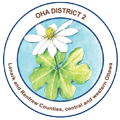CONTACT US
Perth & District Horticultural Society
Perth, ON
Linda Bartlett
President
Click to Email
Webmaster
Linda Bartlett
613-283-8027
PDHS Webmaster
The Perth & District Horticultural Society is affiliated with the Ontario Horticultural Association

Our society falls under District 2 of the OHA

2025 HORTICULTURAL AND DESIGN SHOWS
SHOW SCHEDULE 2025
May - Spring Mini Flower Show
| Section I: | Horticultural Specimen |
| Class 1: | African Violet – any colour – single flower – 1 pot |
| Class 2: | Best potted plant in bloom – other than African Violet – 1 pot – named, if possible |
| Class 3: | Best potted foliage plant – 1 pot – named, if possible |
| Class 4: | Succulent, including cacti – 1 pot |
| Class 5: | Single Tulip – 1 stem with no more than two pairs of leaves attached |
| Class 6: | Double Tulip – 1 stem with no more than two pairs of leaves attached |
| Class 7: | Parrot Tulip – 1 stem with no more than two pairs of leaves attached |
| Class 8: | Narcissus/Daffodil – 1 scape, no foliage attached |
| Class 9: | Flowering Branch – no more than 24” above table |
| Class 10: | Any other spring flower from your garden – one stem – named |
| Class 11: | A Tray of Seedlings - at least six in the tray - named |
| Section II: | Design |
| Class 12: | Spring Forth – A design portraying spring. |
| Class 13: | Itsy Bitsy – A miniature design. |
| Class 14: | Itsy Bitsy – A miniature design (NOVICE). |
| Class 15: | Pik n Plunk – Spring flowers and branches arranged in a vase. |
June - OJES Standard Flower Show
| Section I: | Horticultural Specimen |
| Class 1: | Allium – 1 stem |
| Class 2: | Bearded Iris – 1 spike |
| Class 3: | Delphinium - 1 stem |
| Class 4: | Hosta, small-leaved up to 10cm (4”) leaf base to tip, same cultivar – 3 leaves |
| Class 5: | Hosta, large-leaved over 10cm (4”) leaf base to tip, same cultivar – 3 leaves |
| Class 6: | Peony (any kind) – 1 stem |
| Class 7: | Rose (any kind) – 1 stem or spray |
| Class 8: | Siberian Iris – 1 spike |
| Class 9: | Any other perennial – named – 3 stems |
| Class 10: | Any annual named – 3 stems |
| Class 11: | Collection of Herbs – minimum 3 – named |
| Class 12: | Collection of Hosta, any size, one leaf each of 5 different cultivars, in one container |
| Class 13: | Collection of Peonies – at least 3 stems |
| Class 14: | Rhubarb -3 stalks – displayed on a plate |
| Section II: | Design |
| Class 15A: | “Time for Tea” – a small design in a teacup |
| Class 15B: | “Time for Tea” – a small design in a teacup (Novice) |
| Class 16: | “Nature’s Beauty” – a design using decorative wood and garden flowers |
| Class 17: | “Reach for the Sun” – a vertical line design |
| Class 18: | “First Day of Summer” - a bouquet in a vase |
| Class 19: | “Sunset” – a design |
October - Last of the Season Mini Show
| Section I: | Horticultural Specimen |
| Class 1: | Last Rose of Summer – any cultivar – 1 bloom, stem or spray |
| Class 2: | Any perennial other than rose – 1 bloom or stem - named |
| Class 3: | 3 leaves – same cultivar – named |
| Class 4: | Any annual – 3 stems - named |
| Class 6: | Holiest Hosta Leaf - 1 leaf - most damaged you can find |
| Class 5: | Garlic – 2 bulbs – displayed on a plate |
| Class 7: | Any other vegetable – named (one to a maximum of three each) |
| Section II: | Design |
| Class 8: | Thanksgiving – a design using flowers and/or vegetables for the table |
| Class 9: | Spooked – a Halloween design |
| Class 10: | Last Showing – an arrangement in a vase using fall flowers and ornamental grasses from your garden |
SHOW RULES
- Exhibitors must be members of the Perth & District Horticultural Society.
- Entries are to be placed prior to 7:00 p.m. when judging takes place.
- Once placed, entries may only be moved by the show steward.
- Only one entry per exhibitor for each Design Class.
- Maximum of two entries per exhibitor for each Horticultural Class providing specimens are of different cultivars.
- All entries in Horticultural classes must have been grown or have been in the possession of the exhibitor for three months.
- Entry tag must be completed and remain with the entry.
- The decision of the judge is final.
- No exhibit will receive a prize, even though it is the only one in the class, unless judged to have sufficient merit.
- No exhibit may be moved before the specified closing time.
- All shows will take place during regular meetings.
HORTICULTURAL AND DESIGN DEFINITIONS
In accordance with Ontario Judging and Exhibiting Standards, Second Edition OJES 2019
Novice - A person new to entering competitions, or who has not won any first place ribbons in shows.
Horticultural
- Scape: A leafless flower stem arising from the ground. Each scape may carry a number of flower buds depending on the cultivar, e.g., Hemerocallis, Narcissus
- Spike: An upright stem carrying several flowers which are nearly stemless, e.g. Gladiolus, Liatris.
- Spray: The terminal flowering growth of an herbaceous or woody plant carried on one stem. Ideally it would show all stages of development, e.g. flowers in bloom, buds showing colour, green buds and leaves.
- Stem: A main plant structure which supports flowers, leaves, buds, or fruit.
- Narcissus:
“trumpet” – the cup or corona as long or longer than the perianth segments (surrounding petals), e.g. Mount Hood, Spellbinder.
“large cupped” – the cup or corona is more than1/3 but less than equal to the length of the perianth segments, e.g., Ice Follies, Carlton.
“small cupped” – the cup or corona is not more than 1/3 the size of the perianth, Birma, Barrett Browning. - Tulip:
“double” – should be shown approximately 3/4 open.
“parrot” – the form is ragged, artistically-shaped petals, sepals twisted, deeply cut. May be single or double.
“single” – the classic egg and oval form types.
Designs
- Design - A combination of fresh and/or dried plant materials, with or without other objects arranged to create an artistic unit. A design may include container(s), base(s) and/or accessories. The designer uses the elements of design: space, line, form, colour, texture and pattern in the accepted principles of design: balance, rhythm, proportion, scale, contrast and dominance to interpret the theme and/or class and create a design of harmony and distinction.
- Miniature Design - A design with maximum dimensions no more than 12.7 cm (5”) in height, width and depth including any container, base and/or accessories.
- Small Design - A design from 14 cm to 25.4 cm (5 1/2" to 10") and which must not exceed 25.4 cm (10") in height, width and depth including any container, base and/or accessories.
- Bouquet - A design artistically created by grouping plant material, with or without accessories, using their own stems. May be inserted into a holder or container.
- Vertical Design - A design in which components are arranged on an axis perpendicular to the horizon.
- Wayside Design – A design composed of common and plentiful flowers, foliage, fungi and/or weeds such as bulrushes, ox-eye daisy, Queen Anne's Lace, goldenrod, etc. Plant species listed as endangered, threatened, of special concern or invasive should not be used. See Endangered Species and Invasive Plants for further details and -sources of current lists of these plants. Canada - Species at Risk Public Registry and Ontario Wildlife and Nature (Species at Risk and Invasive Species)
- Weathered Wood – Wood that has been altered in form, colour and/or texture by the forces of nature; a type of decorative wood.
For more definitions and information, please refer to the Ontario Judging & Exhibiting Standards – Second Edition, OJES 2019.
TIPS FOR PREPARING ENTRIES FOR EXHIBITING
The exhibitor wants to show the highest quality of plant material possible, from the time of selecting specimens to placing them in the proper classes. List or mark in the schedule the plants you are growing that will be at the proper stage for showing. Cut flowers and foliage the night before the show or early in the morning. Bring extra ones for back-up in a separate container.
Prepare plant materials for hardening
- Remove lower foliage cleanly. Upper foliage must be attached unless otherwise stated.
- Specimen blooms should not have side buds. In fact, good exhibitors will often disbud weeks before the Show.
- Make a fresh cut, with the end of stems under water, for maximum water intake.
- Place in a wide bucket in warm water for at least three hours, preferably overnight.
- Store in a cool, dark humid, draft-free place.
- Re-cut stems before placing in show containers.
Conditioning: Some cut flowers, foliage and woody materials do not readily absorb water and require further treatment prior to hardening, to prevent wilting during the show.
- Ornamental branches generally benefit from splitting the cut ends. Some also may require removal of the thick outer layer.
- Some cut flowers which exude a white latex or sap benefit from burning the stem ends, e.g., Poppies, Euphorbia.
- Other cut flowers, benefit from placing stem ends in 2" (5cm) of boiling water for a minute or two before placing in cold water, e.g., Dahlias, Roses and Rudbeckia. Protect bloom with a paper collar.
- Some spring bulbs prefer being placed in 2" (5cm) of cold water.
- To prolong the life of a tulip, the small air sac at the very top of the stem where the bloom joins the stem should be pierced with a pin to allow water to flow up to the bloom.
Grooming is essential. Remove evidence of insects, disease, dust, stains, pollen, and any other foreign material from blooms and foliage.
Caution:
- A bud showing colour is considered a bloom.
- Only attached foliage is permitted unless otherwise stated in the schedule.
- Wiring, oiling, spraying and artificial colour are prohibited in the Horticultural Division.
- Check schedule for required number of specimens in the exhibit.